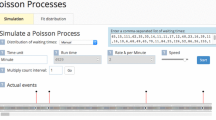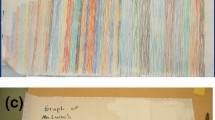Abstract
This paper presents a case study of students (age 14–15) as they attempt to make sense of distribution, adopting a range of causal meanings for the variation observed in the animated computer display and in the graphs generated by a BasketBall simulation. The student activity is analysed through dimensions of complex causality. The results indicate support for our conjecture that the computer simulation can offer new ways for harnessing causality to facilitate students’ meaning making for variation in distributions of data. In order to bridge the deterministic and the stochastic, the students transfer agency to active representations of distributional parameters, such as average and spread. This study finds that, whereas the stochastic is often seen as a distinct domain of knowledge, some students are able to exploit deterministic meanings to account for variation in terms of probabilistic causality.














Similar content being viewed by others
Notes
Figure 12 shows how it is possible to have successful throws for quite different release angles. This is because it is entirely possible for the ball to go directly into the basket or to enter the basket having rebounded off the backboard.
References
Bandura, A. (1986). Social foundations of thought and action: A social cognitive theory. Englewood Cliffs, NJ: Prentice-Hall.
Bandura, A. (2001). Social cognitive theory: An agentic perspective. Annual Review of Psychology, 52, 1–26.
Bandura, A. (2006). Toward a psychology of human agency. Association for Psychological Science, 1(2), 164–180.
Carlson, R. A. (2002). Conscious intentions in the control of skilled mental activity. In B. Ross (Ed.), The psychology of learning and motivation (Vol. 41, pp. 191–228). San Diego, CA: Academic Press.
deCharms, R. (1987). The burden of motivation. In M. L. Maehr & D. A. Kleiber (Eds.), Advances in motivation and achievement: Enhancing motivation (Vol. 5, pp. 1–21). Greenwich, CT: JAI Press.
Deci, E. L., & Ryan, R. M. (1991). A motivational approach to self: Integration in personality. In R. Dienstbier (Ed.), Nebraska symposium on motivation: Perspectives on motivation (Vol. 38, pp. 237–288). Lincoln: University of Nebraska press.
Fischbein, E. (1975). The intuitive sources of probabilistic thinking in children. Dordrecht, The Netherlands: Reidel.
Glaser, B. G. (1978). Theoretical sensitivity: Advances in the methodology of grounded theory. Mill Valley, CA: Sociology Press.
Gould, R. (2004). Variability: One statistician’s view. Statistics Education Research Journal, 3(2), 7–16.
Grotzer, A. T., & Perkins, N. D. (2000). A taxonomy of causal models: The conceptual leaps between models and students’ reflections on them. National Association of Research in Science Teaching (NARST), New Orleans.
Kapadia, R., & Borovcnik, M. (Eds.). (1991). Chance encounters: Probability in education. Dordrecht: Kluwer Academic Publishers.
Mason, J. (1994). Researching from the inside in mathematics education—locating an I—you relationship. In J. P. da Ponte & J. F. Matos (Eds.), Proceedings of the eighteenth international conference for the psychology of mathematics education (Vol. 1) (pp. 176–194). Portugal: University of Lisbon.
Noss, R., & Hoyles, C. (1996). Windows on mathematical meanings: Learning cultures and computers. London: Kluwer Academic Publishers.
Papert, S. (1996). An exploration in the space of mathematics educations. International Journal of Computers for Mathematical Learning, 1(1), 95–123.
Piaget, J., & Inhelder, B. (1975). The Origin of the Idea of Chance in Children (L. J. Leake & P. D. Burell & H. D. Fischbein, Trans.). London: Routledge & Kegan Paul. (Original work published in 1951).
Pratt, D. (1998a). The construction of meanings in and for a stochastic domain of abstraction. Unpublished PhD Thesis, University of London, London.
Pratt, D. (1998b). The co-ordination of meanings for randomness. For the Learning of Mathematics, 18(3), 2–11.
Pratt, D. (2000). Making sense of the total of two dice. Journal for Research in Mathematics Education, 31(5), 602–625.
Prodromou, T. (2008). Connecting thinking about distribution. Unpublished PhD Thesis, University of Warwick, United Kingdom.
Prodromou, T. (2012). Students’ construction of meanings about the co-ordination of the two epistemological perspectives on distribution. International Journal of Statistics and Probability, 1(2), 283–300. doi:10.5539/ijsp.v1n2p283.
Prodromou, T., & Pratt, D. (2006). The role of causality in the co-ordination of the two perspectives on distribution within a virtual simulation. Statistics Education Research Journal, 5(2), 69–88.
Robson, C. (1993). Real world research. Oxford: Blackwell.
White, R. W. (1959). Motivation reconsidered: The concept of competence. Psychological Review, 66, 297–333.
Wilensky, U. (1991). Abstract meditations on the concrete and concrete implications for mathematics education. In I. Harel & S. Papert (Eds.), Constructionism (pp. 193–204). Norwood, New Jersey: Ablex.
Author information
Authors and Affiliations
Corresponding author
Rights and permissions
About this article
Cite this article
Prodromou, T., Pratt, D. Making Sense of Stochastic Variation and Causality in a Virtual Environment. Tech Know Learn 18, 121–147 (2013). https://doi.org/10.1007/s10758-013-9210-4
Published:
Issue Date:
DOI: https://doi.org/10.1007/s10758-013-9210-4




